stop start Lancia Thesis 2007 Owner handbook (in English)
[x] Cancel search | Manufacturer: LANCIA, Model Year: 2007, Model line: Thesis, Model: Lancia Thesis 2007Pages: 386, PDF Size: 8.69 MB
Page 70 of 386
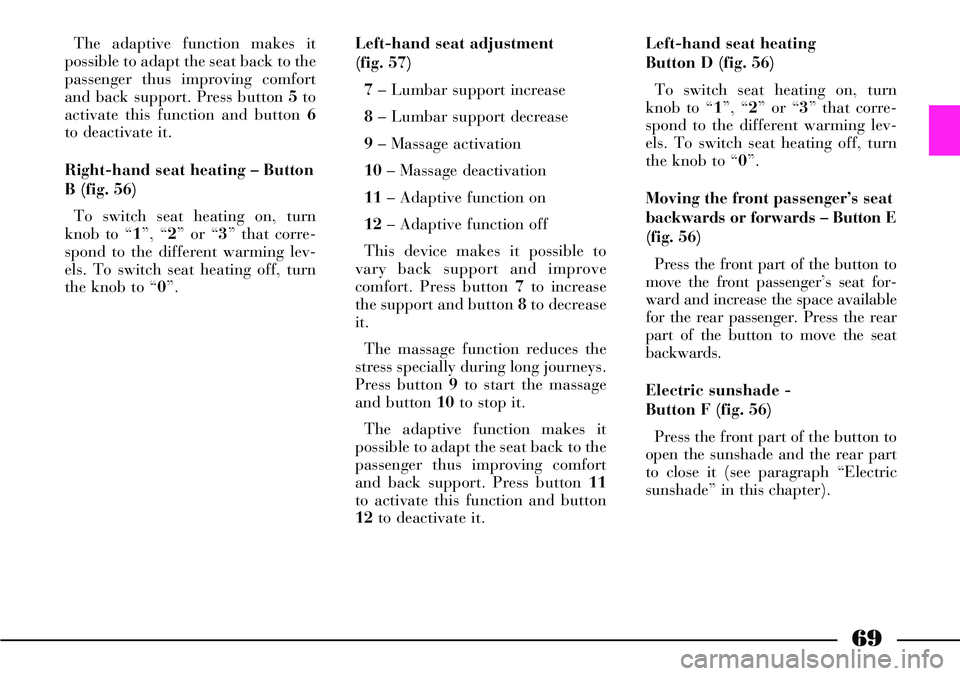
69
The adaptive function makes it
possible to adapt the seat back to the
passenger thus improving comfort
and back support. Press button 5to
activate this function and button 6
to deactivate it.
Right-hand seat heating – Button
B (fig. 56)
To switch seat heating on, turn
knob to “1”, “2” or “3” that corre-
spond to the different warming lev-
els. To switch seat heating off, turn
the knob to “0”.Left-hand seat adjustment
(fig. 57)
7– Lumbar support increase
8– Lumbar support decrease
9 – Massage activation
10– Massage deactivation
11– Adaptive function on
12– Adaptive function off
This device makes it possible to
vary back support and improve
comfort. Press button 7to increase
the support and button 8to decrease
it.
The massage function reduces the
stress specially during long journeys.
Press button 9to start the massage
and button 10to stop it.
The adaptive function makes it
possible to adapt the seat back to the
passenger thus improving comfort
and back support. Press button 11
to activate this function and button
12to deactivate it.Left-hand seat heating
Button D (fig. 56)
To switch seat heating on, turn
knob to “1”, “2” or “3” that corre-
spond to the different warming lev-
els. To switch seat heating off, turn
the knob to “0”.
Moving the front passenger’s seat
backwards or forwards – Button E
(fig. 56)
Press the front part of the button to
move the front passenger’s seat for-
ward and increase the space available
for the rear passenger. Press the rear
part of the button to move the seat
backwards.
Electric sunshade -
Button F (fig. 56)
Press the front part of the button to
open the sunshade and the rear part
to close it (see paragraph “Electric
sunshade” in this chapter).
Page 80 of 386

LOAD LIMITING DEVICES
In order to increase passive safety,
the front and rear seat belt reels
have a built-in load limiting device
which collapse in a controlled fash-
ion so to dose the force on the pas-
senger’s shoulder and chest during
the retaining operation. GENERAL INSTRUCTIONS FOR
THE USE OF THE SEAT BELTS
The driver must comply with (and
have the vehicle occupants follow)
all the local legal regulations con-
cerning the use of seat belts.
Always fasten the seat belts before
starting.The belt should not be
twisted, make sure that it
is taut and adheres to the
passenger’s body. The upper part
should pass over the shoulder
and cross the chest diagonally.
The lower part should adhere to
the pelvis and to the abdomen of
the passenger (fig. 73). Do not use
any objects (pegs, stoppers, etc.)
to keep the belts away from the
body.
For maximum safety,
keep the back of your seat
upright, lean back into it
and make sure the seat belt fits
closely across your chest and
hips.
Make sure that the seat belts of
the front and rear passengers are
fastened at all times! You
increase the risk of serious injury
or death in a collision if you trav-
el with the belts unfastened.
fig. 73
L0A0004b
Operations which lead
to knocks, vibrations or
localised heating (over
100°C for a maximum of 6 hours)
in the area around the preten-
sioners may cause damage or
trigger them. These devices are
not affected by vibrations caused
by irregularities of the road sur-
face or low obstacles such as
kerbs, etc. Contact a Lancia
Dealership for any assistance.
79
Page 104 of 386
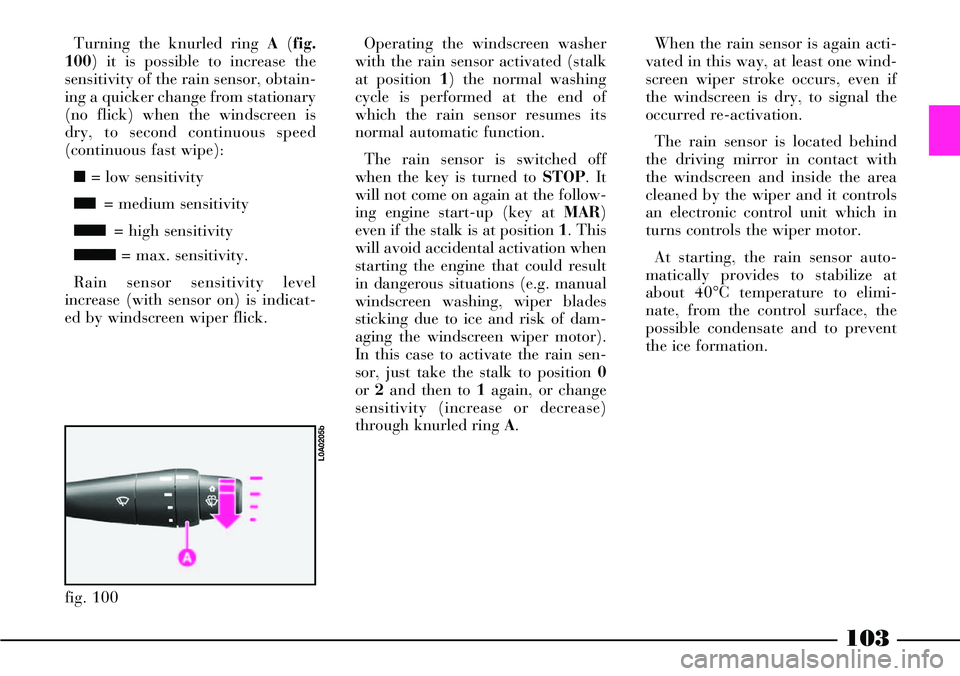
103
Operating the windscreen washer
with the rain sensor activated (stalk
at position 1) the normal washing
cycle is performed at the end of
which the rain sensor resumes its
normal automatic function.
The rain sensor is switched off
when the key is turned to STOP. It
will not come on again at the follow-
ing engine start-up (key at MAR)
even if the stalk is at position 1. This
will avoid accidental activation when
starting the engine that could result
in dangerous situations (e.g. manual
windscreen washing, wiper blades
sticking due to ice and risk of dam-
aging the windscreen wiper motor).
In this case to activate the rain sen-
sor, just take the stalk to position 0
or2and then to 1again, or change
sensitivity (increase or decrease)
through knurled ring A. When the rain sensor is again acti-
vated in this way, at least one wind-
screen wiper stroke occurs, even if
the windscreen is dry, to signal the
occurred re-activation.
The rain sensor is located behind
the driving mirror in contact with
the windscreen and inside the area
cleaned by the wiper and it controls
an electronic control unit which in
turns controls the wiper motor.
At starting, the rain sensor auto-
matically provides to stabilize at
about 40°C temperature to elimi-
nate, from the control surface, the
possible condensate and to prevent
the ice formation. Turning the knurled ring A(fig.
100) it is possible to increase the
sensitivity of the rain sensor, obtain-
ing a quicker change from stationary
(no flick) when the windscreen is
dry, to second continuous speed
(continuous fast wipe):
■= low sensitivity
■■= medium sensitivity
■■■= high sensitivity
■■■■= max. sensitivity.
Rain sensor sensitivity level
increase (with sensor on) is indicat-
ed by windscreen wiper flick.
fig. 100
L0A0205b
Page 109 of 386
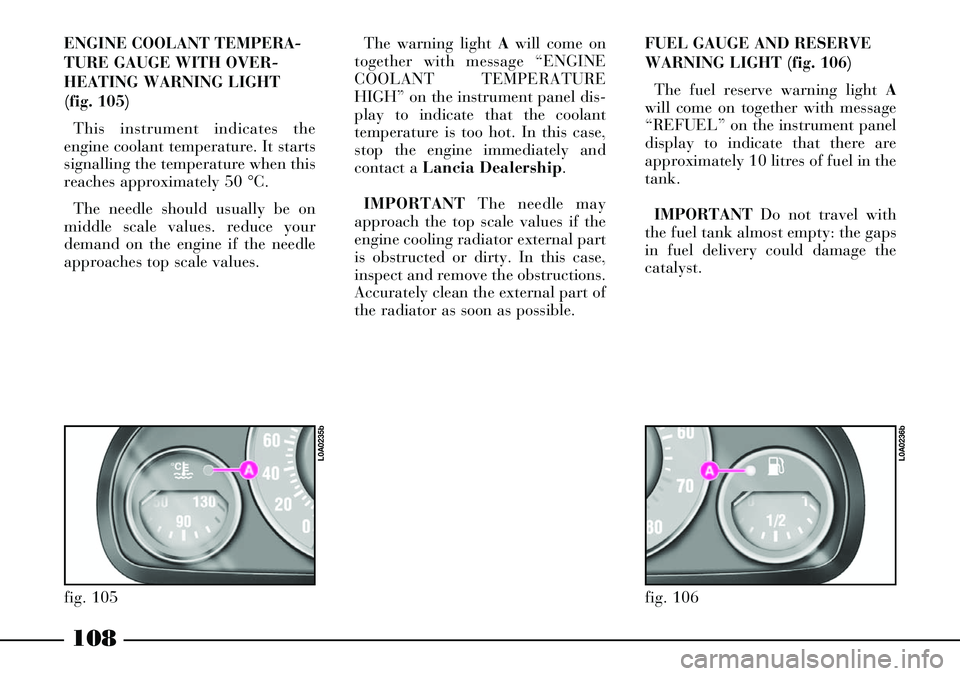
108
fig. 106
L0A0236b
ENGINE COOLANT TEMPERA-
TURE GAUGE WITH OVER-
HEATING WARNING LIGHT
(fig. 105)
This instrument indicates the
engine coolant temperature. It starts
signalling the temperature when this
reaches approximately 50 °C.
The needle should usually be on
middle scale values. reduce your
demand on the engine if the needle
approaches top scale values.The warning light Awill come on
together with message “ENGINE
COOLANT TEMPERATURE
HIGH” on the instrument panel dis-
play to indicate that the coolant
temperature is too hot. In this case,
stop the engine immediately and
contact a Lancia Dealership.
IMPORTANTThe needle may
approach the top scale values if the
engine cooling radiator external part
is obstructed or dirty. In this case,
inspect and remove the obstructions.
Accurately clean the external part of
the radiator as soon as possible.FUEL GAUGE AND RESERVE
WARNING LIGHT (fig. 106)
The fuel reserve warning light A
will come on together with message
“REFUEL” on the instrument panel
display to indicate that there are
approximately 10 litres of fuel in the
tank.
IMPORTANTDo not travel with
the fuel tank almost empty: the gaps
in fuel delivery could damage the
catalyst.
fig. 105
L0A0235b
Page 118 of 386
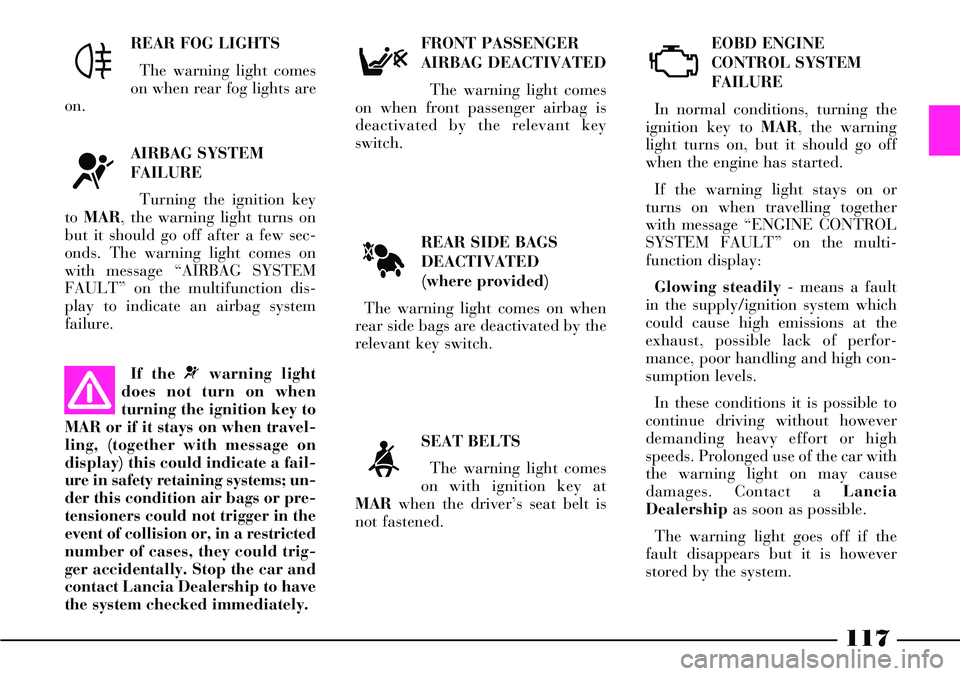
117
REAR SIDE BAGS
DEACTIVATED
(where provided)
The warning light comes on when
rear side bags are deactivated by the
relevant key switch.EOBD ENGINE
CONTROL SYSTEM
FAILURE
In normal conditions, turning the
ignition key to MAR, the warning
light turns on, but it should go off
when the engine has started.
If the warning light stays on or
turns on when travelling together
with message “ENGINE CONTROL
SYSTEM FAULT” on the multi-
function display:
Glowing steadily- means a fault
in the supply/ignition system which
could cause high emissions at the
exhaust, possible lack of perfor-
mance, poor handling and high con-
sumption levels.
In these conditions it is possible to
continue driving without however
demanding heavy effort or high
speeds. Prolonged use of the car with
the warning light on may cause
damages. Contact a Lancia
Dealershipas soon as possible.
The warning light goes off if the
fault disappears but it is however
stored by the system. FRONT PASSENGER
AIRBAG DEACTIVATED
The warning light comes
on when front passenger airbag is
deactivated by the relevant key
switch.
SEAT BELTS
The warning light comes
on with ignition key at
MARwhen the driver’s seat belt is
not fastened.
F
<
U
À
REAR FOG LIGHTS
The warning light comes
on when rear fog lights are
on.
AIRBAG SYSTEM
FAILURE
Turning the ignition key
to MAR, the warning light turns on
but it should go off after a few sec-
onds. The warning light comes on
with message “AIRBAG SYSTEM
FAULT” on the multifunction dis-
play to indicate an airbag system
failure.
4
¬
If the ¬warning light
does not turn on when
turning the ignition key to
MAR or if it stays on when travel-
ling, (together with message on
display) this could indicate a fail-
ure in safety retaining systems; un-
der this condition air bags or pre-
tensioners could not trigger in the
event of collision or, in a restricted
number of cases, they could trig-
ger accidentally. Stop the car and
contact Lancia Dealership to have
the system checked immediately.
Page 159 of 386

158
IMPORTANTAir at a temperature
lower than that of the outside air
cannot be let in to the passenger
compartment when the compressor
is off. Furthermore, in particular
environmental conditions, the win-
dows could mist up fast because the
air is no longer dehumidified.
The setting will be stored when the
engine is stopped. Either press √
button again or press the AUTObut-
ton to reset automatic control of the
compressor (in the latter case, the
manual settings will be cancelled).
The led on the √button will go out. IMPORTANTThe air recircula-
tion function will allow, according to
the system operation (i.e. heating or
cooling) to reach the required condi-
tions faster. We recommend not
turning on this function on rainy
and/or cold days as this will consid-
erably increase window misting,
especially if the climate control sys-
tem is off.
In particular climate
conditions (e.g. low out-
side temperature or high
humidity) and with the inside air
recirculation automatic control
on, windows could start misting
up. In this case, press the air
recirculation button and set it to
forced open position (both button
leds off), and increase air flow to
the windscreen, if required.Climate control system
compressor off button (7 fig. 121)
Press the √button, when the but-
ton led is on, to switch the air condi-
tioner compressor off. The led will
go off. By pressing again the button
when the led is off, the system auto-
matic control of the compressor acti-
vation is restored; this situation is
indicated by button led lighting up.
When the air conditioner compres-
sor is off, if the system is no longer
able to keep the requested tempera-
ture, the message FULL AUTOon
the display turns off and the system
deactivates air recirculation to pre-
vent window misting up. Instead, if
the system is still able to maintain
the requested temperature, the mes-
sage FULLon the display will stay
on.
Page 161 of 386
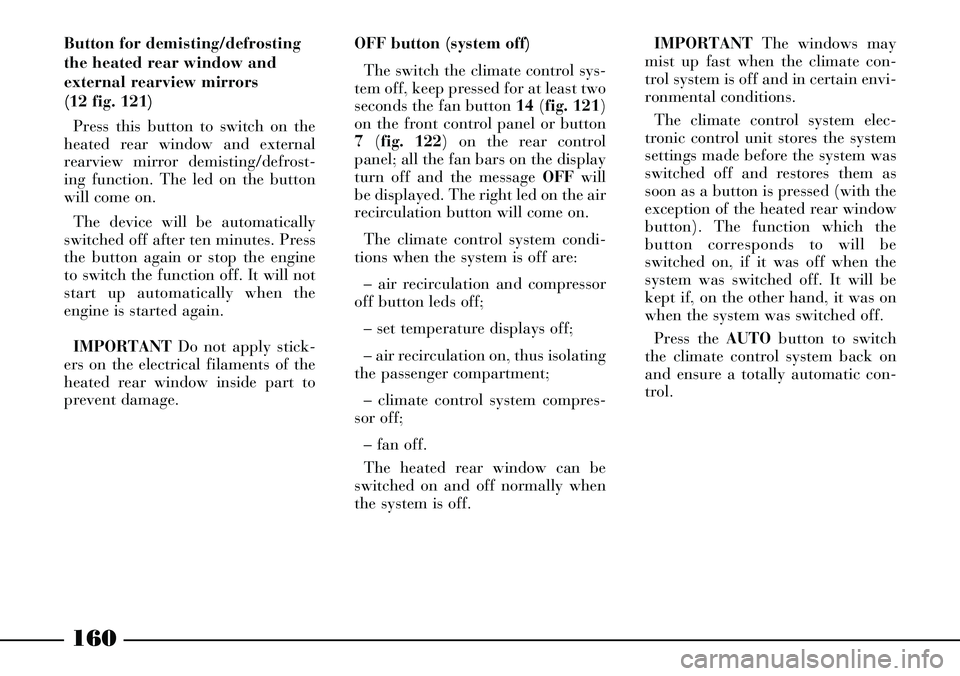
160
Button for demisting/defrosting
the heated rear window and
external rearview mirrors
(12 fig. 121)
Press this button to switch on the
heated rear window and external
rearview mirror demisting/defrost-
ing function. The led on the button
will come on.
The device will be automatically
switched off after ten minutes. Press
the button again or stop the engine
to switch the function off. It will not
start up automatically when the
engine is started again.
IMPORTANTDo not apply stick-
ers on the electrical filaments of the
heated rear window inside part to
prevent damage.OFF button (system off)
The switch the climate control sys-
tem off, keep pressed for at least two
seconds the fan button 14 (fig. 121)
on the front control panel or button
7 (fig. 122) on the rear control
panel; all the fan bars on the display
turn off and the message OFFwill
be displayed. The right led on the air
recirculation button will come on.
The climate control system condi-
tions when the system is off are:
– air recirculation and compressor
off button leds off;
– set temperature displays off;
– air recirculation on, thus isolating
the passenger compartment;
– climate control system compres-
sor off;
– fan off.
The heated rear window can be
switched on and off normally when
the system is off.IMPORTANTThe windows may
mist up fast when the climate con-
trol system is off and in certain envi-
ronmental conditions.
The climate control system elec-
tronic control unit stores the system
settings made before the system was
switched off and restores them as
soon as a button is pressed (with the
exception of the heated rear window
button). The function which the
button corresponds to will be
switched on, if it was off when the
system was switched off. It will be
kept if, on the other hand, it was on
when the system was switched off.
Press the AUTObutton to switch
the climate control system back on
and ensure a totally automatic con-
trol.
Page 162 of 386

161
ACTIVE CARBON
DUST/POLLEN FILTER
The filter has the specific capacity
of combining a mechanical air
cleaning action and an electrostatic
effect so that the air let into the pas-
senger compartment is purified from
particles such as dust, pollen, etc.
In addition to this function, the fil-
ter efficaciously reduces the concen-
tration of pollutants thanks to a
layer of active carbon inside the fil-
ter.
The filtering action is carried out
on the air let in from outside (recir-
culation off).
Have the filter checked at least
once a year at a Lancia
Dealership, ideally at the begin-
ning of the summer.The efficacy of the cli-
mate control system may
be considerably reduced
if the filter is not replaced.Fan actuation is automatic and air
distribution corresponds to the latest
setting made before switching the
car off.
This function is useful especially on
summer days since it greatly reduces
the temperature inside the passenger
compartment as well as the duration
of the cooling cycle after car start-
up, thus avoiding the accumulation
of warm air in the air conditioning
unit lines.
IMPORTANTBest operation of
the fan when the car is parked is
obtained by closing completely the
windows and sunroof. Furthermore,
to check operation at first speed of
the fan, disengage air vents and set
air distribution from central dash-
board vents only before leaving the
car.You should have the filter checked
and if required replaced more fre-
quently if the car is mainly used in
polluted or dusty areas.
VENTILATION DURING A STOP
In versions with sunroof, the roof
top features 21 photovoltaic cells
supplying a maximum power of 24
W to supply the climate control sys-
tem fan when the car is parked with
the roof closed or horizontally pivot-
ing.
Page 163 of 386
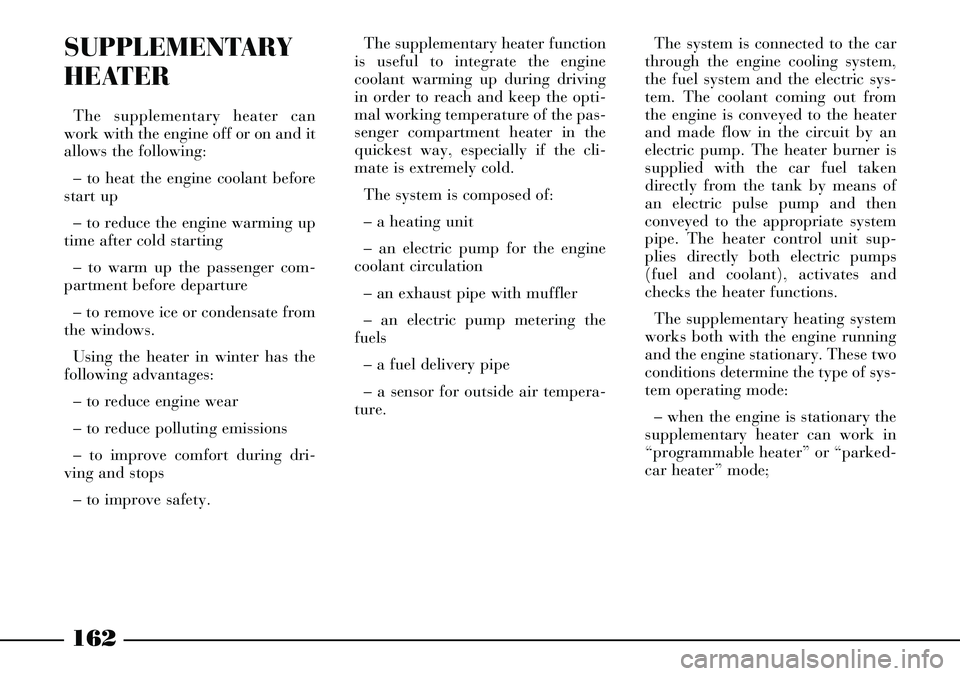
162
SUPPLEMENTARY
HEATER
The supplementary heater can
work with the engine off or on and it
allows the following:
– to heat the engine coolant before
start up
– to reduce the engine warming up
time after cold starting
– to warm up the passenger com-
partment before departure
– to remove ice or condensate from
the windows.
Using the heater in winter has the
following advantages:
– to reduce engine wear
– to reduce polluting emissions
– to improve comfort during dri-
ving and stops
– to improve safety.The supplementary heater function
is useful to integrate the engine
coolant warming up during driving
in order to reach and keep the opti-
mal working temperature of the pas-
senger compartment heater in the
quickest way, especially if the cli-
mate is extremely cold.
The system is composed of:
– a heating unit
– an electric pump for the engine
coolant circulation
– an exhaust pipe with muffler
– an electric pump metering the
fuels
– a fuel delivery pipe
– a sensor for outside air tempera-
ture.The system is connected to the car
through the engine cooling system,
the fuel system and the electric sys-
tem. The coolant coming out from
the engine is conveyed to the heater
and made flow in the circuit by an
electric pump. The heater burner is
supplied with the car fuel taken
directly from the tank by means of
an electric pulse pump and then
conveyed to the appropriate system
pipe. The heater control unit sup-
plies directly both electric pumps
(fuel and coolant), activates and
checks the heater functions.
The supplementary heating system
works both with the engine running
and the engine stationary. These two
conditions determine the type of sys-
tem operating mode:
– when the engine is stationary the
supplementary heater can work in
“programmable heater” or “parked-
car heater” mode;
Page 165 of 386
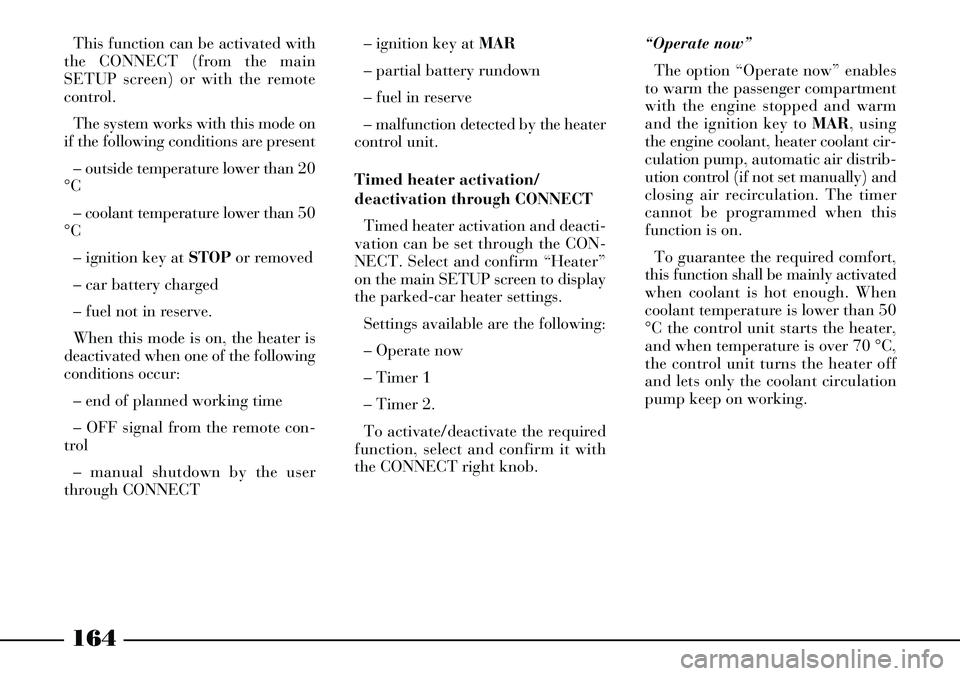
164
This function can be activated with
the CONNECT (from the main
SETUP screen) or with the remote
control.
The system works with this mode on
if the following conditions are present
– outside temperature lower than 20
°C
– coolant temperature lower than 50
°C
– ignition key at STOPor removed
– car battery charged
– fuel not in reserve.
When this mode is on, the heater is
deactivated when one of the following
conditions occur:
– end of planned working time
– OFF signal from the remote con-
trol
– manual shutdown by the user
through CONNECT– ignition key at MAR
– partial battery rundown
– fuel in reserve
– malfunction detected by the heater
control unit.
Timed heater activation/
deactivation through CONNECT
Timed heater activation and deacti-
vation can be set through the CON-
NECT. Select and confirm “Heater”
on the main SETUP screen to display
the parked-car heater settings.
Settings available are the following:
– Operate now
– Timer 1
– Timer 2.
To activate/deactivate the required
function, select and confirm it with
the CONNECT right knob.“Operate now”
The option “Operate now” enables
to warm the passenger compartment
with the engine stopped and warm
and the ignition key to MAR, using
the engine coolant, heater coolant cir-
culation pump, automatic air distrib-
ution control (if not set manually) and
closing air recirculation. The timer
cannot be programmed when this
function is on.
To guarantee the required comfort,
this function shall be mainly activated
when coolant is hot enough. When
coolant temperature is lower than 50
°C the control unit starts the heater,
and when temperature is over 70 °C,
the control unit turns the heater off
and lets only the coolant circulation
pump keep on working.